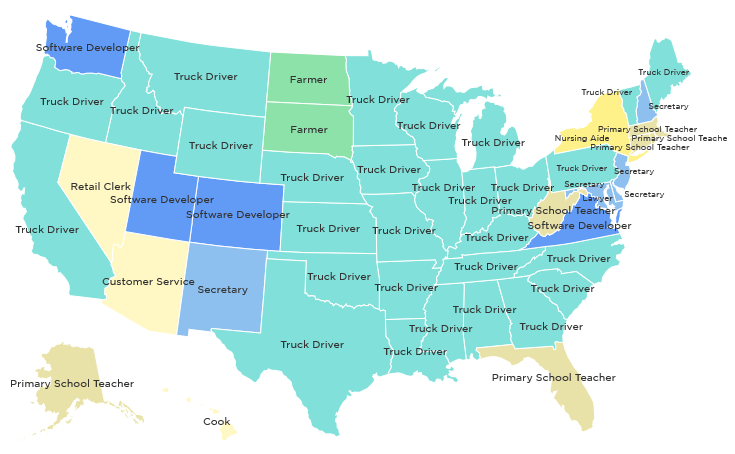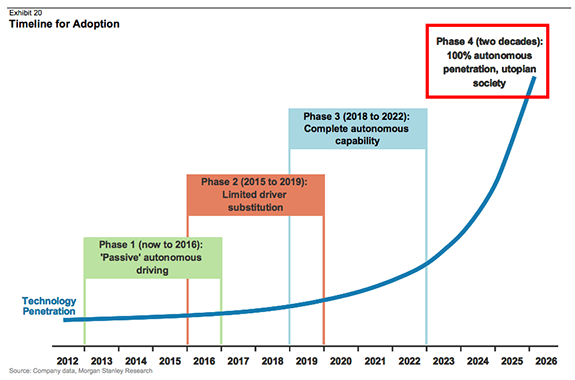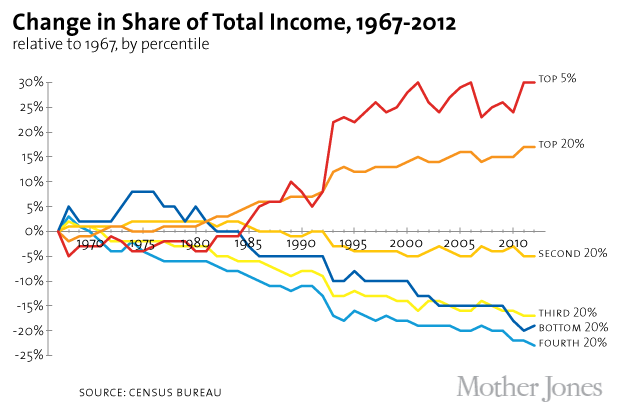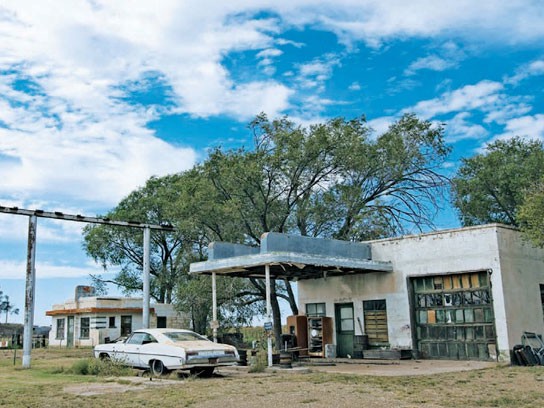Autonomous trucks will spread our asphalt society
- Transfer
It is urgent to introduce unconditional income in view of the future future of romo mobiles.
Last year, my friend and I drove by car from New Orleans (Louisiana) to Orlando (Florida), and, driving through the city outside the city, we talked about the potential effect that robomobili will have on not only truckers, but also on the entire local economy, depending from their salaries. And when you start thinking about the consequences of such a blow in the stomach for America, you realize that the future is not so bright.
The economies of small cities will noticeably subside - we have not known such shocks since we built the interstate highway system . If you think that I am exaggerating - let me tell you this:

the map shows the most popular professions in 2014
And this should immediately tell you how much the American economy depends on truck drivers. According to the American Association of Truckers (ATA), there are 3.5 million of them in the United States , and another 5.2 million people in the trucking industry are not driving. In total, we get 8.7 million people whose work is related to trucks.
But the revenues earned by these millions create jobs for other people. 3.5 million truckers stop to eat, drink, rest and sleep. Whole enterprises are built around them. Restaurants and motels are just two examples. That is, there are still millions of people who depend on truckers for work. But that's not all.
Employees of restaurants and motels are also buyers in their local economies. Waiters and maids also spend their incomes, which ultimately creates jobs again - that is, we now have not only millions of people who depend on truckers, but also entire cities that depend on all of the above citizens. All these economies will significantly shrink when spending cuts.
Another important detail is a good salary for drivers. About40,000 dollars a year . This is more than 46% of taxpayers. In addition, this is practically the last job in the country, which will provide you with a middle-class salary in the absence of higher education. Truckers are the last representatives of the impoverished population that used to work in production. But now the whole production is brought to other countries.
We have about 10 million working Americans and their families, whose income, partially or directly, depends on the work of truckers.
It turns out that while with the trucks everything is in order, and we will be all right, right?
Short-term working prospects of the American trucker
The freight industry predicts an increase in the number of jobs by 21% by 2020. They also predict an increase in driver shortages - more than 100,000 vacancies are open, which they cannot fill. High demand leads to higher wages, so the next five years for drivers will go well. The only thing that can prevent this is if the need for drivers, so to speak, moves off a cliff.
A breakage will serve as an automatic truck.
All necessary technologies have been developed. Recently, Google hit everyone, announcing that its robomobils had driven 100,000 miles without a single accident. Now they hit 1.7 million miles in just 11 accidents, all of which were caused by people. And this is mainly in the cities.
According to the developers of the system, the accident rate is much lower on the highway: “As expected, accidents happen more often in the city than on the highway - during a city trip we were hit 8 times,” said Chris Urmson, director of development of mobile phones at Google . Therefore, driving outside the cities is even less technologically complex, and unmanned vehicles dissecting highways are significantly closer to us. And how close? Yes, they are already driving.
The first cargo operator went onto the road on May 6, 2015.
This is not the future, but the present. According to Daimler, these trucks will be tested for 10 years and will hit more than a million miles before they are commercially available. But this technology itself is not new. There are not even lidars like Google’s cars — usual radars and cameras. Iron is absolutely not new. Daimler was the first to put it on trucks and let the drivers relax on the seat while the truck was driving itself.
If he needs help, he will warn the driver. If he does not respond, the truck will slowly stop and wait for instructions. And this is not a fantasy, not a truck version of KITT from the Knight Rider series. This is just an example of how a company and a state government do not interfere with technology to do what it is intended for - to allow people to achieve more with less. In the case of robotic trucks, one of the advantages will be to reduce the number of accidents.
In 2012, 330,000 trucks took part in an accident in the United States, and 4,000 people were killed - mostly passenger cars. 90% of accidents occurred due to driver error.
Robots will kill far fewer people, because cars do not get tired, do not get distracted, do not look at the phone while driving, do not drink, do not use drugs, etc. Similarly, the pilots will soon be removed from the cockpit . A man is dangerous driving any kind of transport.
And robots do not need salaries - growing due to the fact that fewer and fewer people want to be truckers. The company will buy a fleet of robots and will not pay people for driving, just for car maintenance. No insurance, no rest stops - travel time will be reduced.
It turns out that the replacement of drivers is inevitable - it is not a question of "if", but "when." And what will happen to these millions of drivers who have lost their jobs, and with all the other people?
Long-term working prospects of the American trucker
Consider the graph of the emergence of robots Tesla has released a software update that allows their car to drive independently. Drivers "Tesla" still can not control them at all, but very soon there will be such cars and the relevant laws.

Morgan Stanley believes that fully autonomous cars will appear by 2022, by 2026 they will make a powerful market penetration, and in 20 years ordinary cars will simply disappear.
Yes, of course, this is only a rough estimate. And here are some more predictions:
- Navigant Research : by 2035, sales of romo mobiles will reach 95.4 million annually, and will occupy 75% of the passenger car market
- IHS Automotive : by the year 2035 there will be about 54 million robots in the world
- ABI Research : half of the new cars sold in North America will have an autopilot by 2032
- Nissan : by 2020, cars will have more and more elements of autonomy. This process will be evolutionary, and by 2020 autonomous opportunities will actually begin to appear in serial cars.
We put all this together and get a window in ten years, from 2020 to 2030.
Do not move out of this cliff will not work. What the market needs is what it will get - capitalism and competition. And not only Tesla and Google are engaged in this. The company Veeo Systems is developing all sorts of robomobili, from two-seater cars to 70-seater buses, their testing in 30 US cities will begin by the end of 2016.
Uber is also working on creating its own mobile, and, in addition, wants to eliminate the concept of car owneras a relic of the 20th century. As the general director and founder of Uber Travis Kalanik describes the situation, customers of the service pay not only for the car, but also for the driver. As soon as you don’t have to pay for the driver, traveling to Uber anywhere will be cheaper than owning a car, and as a result, owning a car will become unnecessary.
Such is the potential of ro-mobiles - the extinction of the institute of car ownership. And at the same time, all the industries related to this area will become extinct - mechanics, car washes, parking, jack-parking services, repair, rental, insurance, loans, etc., etc. ... Even public transport can be replaced with robotic cars - and with it all work related to its creation and support.
Well, what about our trucks?
It will be realistic to take forecasts for passenger ro-mobilios, and to move projections on the emergence of robotic trucks closer to the present - after all, trucks without a driver need only drive on the highway. Autonomy “from warehouse to store” is not obligatory for them - it’s enough “from city to city”. In addition, since the companies own trucks, any opportunity to save money by removing drivers from them will be found.
Convoys from trucks , in which the first person leads, and the rest are moving behind him automatically, are already being tested . This not only saves gasoline, but also reduces the number of drivers required. This technology is already working.
In general, the main barrier now is legal, not technical or economic. Most US states must enact laws to support workloads. According to the forecast of Sergey Brin, this can happen as early as 2017. Therefore, to the question “when?” The cargo loggers will enter our economy, the answer will be: “at any moment”.
On the threshold of social and economic cataclysms
The economy of the American hinterland has already suffered over the past decades and continues to suffer. Production has moved overseas, where labor is cheaper because life is cheaper. Companies like Walmart build stores everywhere that require far fewer staff to serve the same number of people than small family stores. Amazon is working to eliminate stores altogether, leaving only fully automated warehouses and delivering goods to the home by the buyer, thereby reducing the number of jobs even further.
Fewer vacancies remain, and commerce is concentrated geographically, and access to money moves away from the lower and middle classes and focuses at the top.

This is what happens when well-paid jobs disappear, and this money is not spent on salaries, but remains in the pockets of business owners, or is spent on lower salaries. Inequality increases, and the land of opportunity disappears. The economy is slowing.
It is in this situation that we are now witnessing the rapid approach of 3 million unemployed truckers and many millions of unemployed from the services that serve them.
The departure of truckers from work will have the same effect on today's cities as the construction of the interstate highway system bypasses the cities. When this system replaced the Route 66, and drivers stopped calling at them, earlier cities flourished into ghosts, like Glenrio in Texas .

Robo-mobiles and robots will lead to the fact that even those people traveling in cars will pass by cities, because they will not have to stop for the night, you can sleep right in the car. And this time there will be no new highways to which businessmen could move. This time, the need for whole cities will disappear.
Last remaining road
In just 10 years, technology will begin to destroy our familiar economy at an ever-increasing rate. Human labor will be less necessary and more disadvantageous than the work of machines. With this, we all will also insist on getting money to buy what cars make for us. It is time to figure out how to provide yourself with money.
Without “technological dividends” on the scale of the whole society, our economy will freeze in paralysis, or we will struggle with progress as such, we will become something like luddites who destroyed the machines that have deprived them of their work. Without an income that is not tied to work, we will have to resist in spite of the fact that we are not replaced by the machines that we ourselves have built precisely in order to replace us.
Just as on roads in ten years cars will drive without drivers, so the 21st century economy will consist of people-consumers, not people-workers, and they will need purchasing power. If we do not provide ourselves in the near future with an unconditional income, then the future will crash into us like a truck. A truck that we directed ourselves to ...
It would be very foolish to allow such an outcome - after all, isn't technology needed to give us the opportunity to get what we want? We should not be afraid of losing a job; we should welcome this opportunity. We should not ask what we will do when the computers take away our jobs. We have to ask what we will get when we become free from them.
